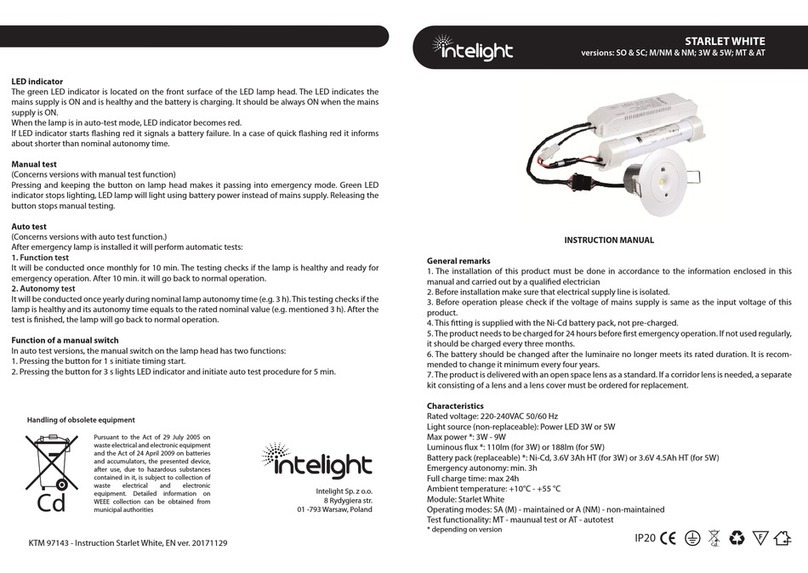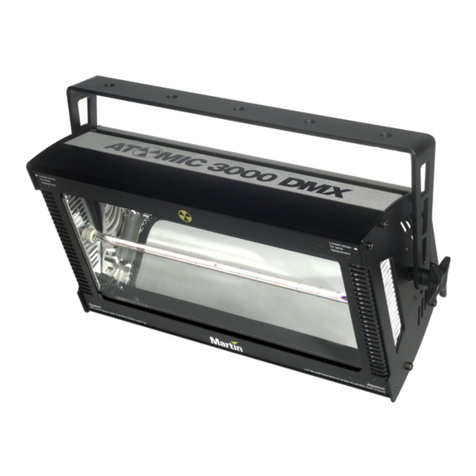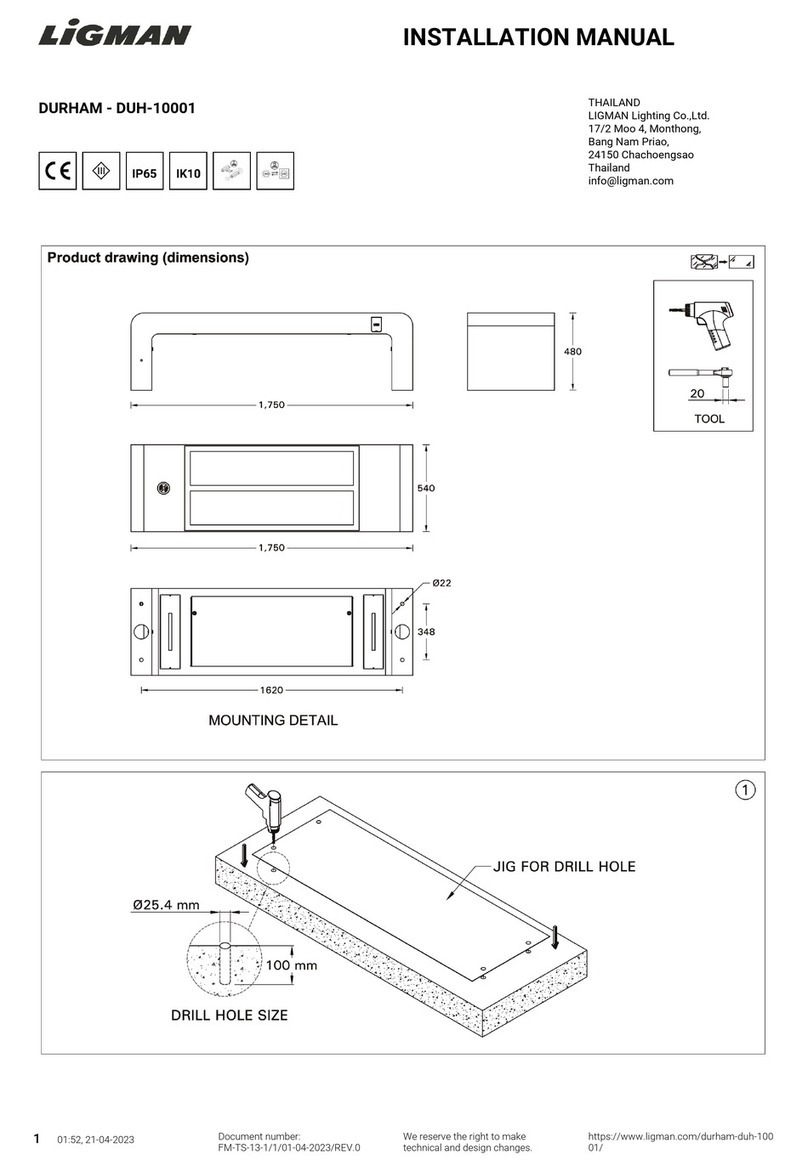Intelight ORION LED 100 User manual

4 KTM 97145 - Instruction ORION LED, EN, ver.20190214 1
MT manual test function
When the emergency luminaire is connected to mains and there is no voltage drop, pressing and holding TEST button will result in
activation of the “voltage drop” mode, the signal LED will go off and the luminaire should light up When the button is released -
the luminaire will switch back into its standard operation mode
The above action means that in a case of emergency mode version the luminaire will go from unlit to illuminated In a case of mains
and emergency mode the luminaire will change a power source, from mains to a battery supply, the switch-over moment should be
visible as a quick blink – during a very short while the light source will be off
CAUTION! In a case of SA (M) luminaire version, but wired as A (NM) one, the lamp behaves according to A (NM) typical behaviour
CB central battery version
Note – CB version can be equipped in a test button, however it is in this case inactive The button pressing will not cause any
luminaire’s reaction
CB version is being monitored directly by a central battery system controller, in a way depending on such system’s possibilities and
settings
FAULTY OPERATIO A D ITS POSSIBLE DIAG OSIS
LED indicator does not light up
AC power failure
LED indicator is red, the luminaire does not operate (MT version, e.g. in SA / M mode)
Battery pack is damaged or disconnected
The luminaire does not operate in emergency mode the required time for a selected model
It is possible that the battery requires a full charge cycle (24h) If after 24 hours of charging the luminaire still does not keep a
predefined autonomy, it is possible that the battery is run-down or damaged, e g due to possible incorrect formatting and needs to
be replaced
Red LED indicator lights up or blinks
The luminaire performs testing or damage of any part of the luminaire possible Please, refer to the “TESTING” section
RECOMME DED PERIODICAL MAI TE A CE
The luminaire should be tested on regular basis in accordance with valid laws and regulations The results of the tests should be
recorded and stored for the use of a fire safety inspector
One time daily
It is suggested to check visually if the LED indicator in the luminaire lights up in green
One time each month
It is necessary to perform a function test by disconnecting the AC power supply and checking whether the luminaire is operating in
emergency mode - the green LED indicator should turn off, and LED light source light up
One time each year
In order to make an autonomy test, disconnect the AC power supply and test if the luminaire operates in emergency mode for a
specified time If the autonomy time of emergency operation is not sufficient, the battery needs to be fully recharged and the test
is to be carried out again If the result of the test continues to be negative, the battery needs to be replaced
CAUTIO !
All damage that might occur as an effect of the device being used not in accordance to this instruction will result in loss of
guarantee
Used or damaged lamps including batteries, are subject to be recycled They should be delivered to the point of collection of
electrical and battery waste or to the manufacturer
The light source contained in this
luminaire shall only be replaced by
the manufacturer or his service
agent or a similar qualified person
Handling of obsolete equipment
Pursuant to the Act of 29 July 2005 on waste
electrical and electronic equipment and the
Act of 24 April 2009 on batteries and
accumulators, the presented device, after
use, due to hazardous substances contained
in it, is subject to collection of waste
electrical and electronic equipment Detailed
information on WEEE collection can be
obtained from municipal authorities
Intelight Sp. z o.o
.
8, Rydygiera str.
01 -793 Warsaw, Poland
ORIO LED EMERGE CY LUMI AIRE
Inst ll tion nd m inten nce instructions
OV
TECH ICAL SPECIFICATIO S:
Light source (non-replaceable): White LED
Operating modes *: SA - mains and emergency operation (M) or
A - emergency operation (NM)
Test versions *: MT – manual test or
AT – auto test or
CT – central test
Emergency autonomy *: 1h, 2h or 3h
Battery (replaceable) *: NiCd or NiMH 3,6V 1500mAh ÷ 4500 mAh
Battery charging duration max : 24h
Power supply *: MT, AT and CT: 220-240V AC 50Hz
CB (central battery): 220V AC/DC
Max power *: 4W ÷ 7W
Module: Orion LED
Luminous flux *: Versions – 100: 104 lm; 150: 152 lm; 250: 273 lm
Visibility *: 20 metres (with flat cover) or 30 metres (D / DS)
Enclosure IP rating: IP65
Ambient temperature *: 10°C ÷ 55°C (standard) or -25°C ÷ 55°C (LT version)
*- depending on model
I TRODUCTIO
1 The lamp should be installed when power supply is off Safety rules, construction and electrical installation standards should
be followed all the time
2 The luminaire should not be powered with circuits connected to inductive power-receiving devices at the same time This type
of solution may cause damage to the electronic module of the luminaire
3 The luminaire should be used indoors
I STALLATIO
1 Before installation one has to make sure that the luminaire will be connected to 220-240VAC mains by means of a min
1,5mm2 wire
2 Open the luminaire by unscrewing two screws on its ends Remove the cover
3 Open the reflector plate with LED light source either by unscrewing two screws at indicated points (for Orion LED 100) or
releasing two plastic locks (Orion LED 150/250/D) Leave it on hinges
4 Cut out an opening in the body for power supply wires When making openings in the body, bear in mind the IP rating of the
body and use appropriate sealing afterwards It is necessary to use either grommets or cable glands to maintain IP65
protection level
5 Install the body of the luminaire on the wall or ceiling, making the information label visible for people who will carry out
testing in future
ORION LED 100
ORION LED 1
50/250
ORION LED
D
ORION LED
DS

2 3
6 Prepare power cable and connect all the wires to the appropriate terminal block entries
7 The description of luminaire terminals:
L - phase wire - brown or black insulation colour; power source for battery charging, presence signalled by signal LED lighting
up in green;
L1 - a terminal to be optionally used for a wall switch connection, enabling to switch a luminaire off during M mode operation,
if no switch is used the terminal L1 should be connected to a phase wire in parallel with the L terminal;
- neutral wire - blue insulation colour;
PE - earth wire - yellow and green insulation colour
8 Luminaire designed for EMERGE CY operation (A, M). To wire a luminaire designed for a Non-Maintained operation, AC
mains power has to be connected to appropriate terminals: L (phase) and (neutral) Always remember about connecting the
protection earth wire (PE) The luminaire should be constantly supplied by power - voltage drop on L will result in emergency
mode activation
9 Luminaire designed for MAI S A D EMERGE CY operation (SA, M). To wire a luminaire designed for a Maintained
operation, AC mains supply needs to be connected to appropriate terminals: L (phase), (neutral) and L1 (wall switch wire)
Always remember about connecting the protection earth wire (PE) L1 terminal can be optionally connected through a wall
switch, enabling switching the luminaire off for a time (the luminaire stays ready for an emergency operation) The luminaire
should be constantly AC supplied, phase loss on L will cause automatic activation of the emergency mode
10 Please remember to indicate the date of installation on the label attached to the battery pack
11 Insert the battery plug into the socket on the PCB
12 Close the reflector/LED plate and fix it to the body, using either screws or locks, depending on model
13 Install the diffuser and screw it to the body If a luminaire with flat cover is to be used as directional (one-sided), one need to
stick a desired pictogram on it, too If an optional DS directional set is being installed, one need to fix (in pair with the diffuser,
on its outside, by means of same screws) a metal frame with PMMA light guide plate put inside, on which desired pictograms
were stuck prior to this assembly
14 One need to remember about sticking the desired pictograms for version D (with a high cover) and DS (with an optional DS
set), in the latter case this operation should be done before final assembly of the DS set Sticking the pictogram for a version
with a flat cover is optional, depending on planned use
15 Orion LED 100, 150 or 250 versions, which will work as directional luminaires, either by means of a pictogram stuck on a flat
transparent cover or by using a DS directional set, require a modification of their marking
in the third segment of the classification table by putting there the letter G, by means of
a permanent marker
16 For versions being installed in a recessed ceiling, one need first to make a hole with dimensions 550x125mm in the ceiling,
then screw the base into the upper arms of the frame by means of attached M4x10 screws Installation in the ceiling is being
done using springs mounted on both sides of the PT frame
17 After the luminaire is being installed, one need to mark (on label, by means of a
permanent marker) if the luminaire was installed as surface one or as recessed one See
on right both markings:
18 For quick operation testing – switch on the AC power supply The green LED indicator should light up, signaling the battery
charging
19 First-time charge of the luminaire battery pack should be carried out continuously for 48 hours This will allow appropriate
formatting of the battery pack During the first-time charge, no testing should be carried out and power supply should not be
disconnected for any other purpose Power supply should be disconnected after 48 hours for the first time The luminaire
should complete a full emergency operation cycle, after which it should be connected to power supply for another 36 hours
This sequence shall complete the formatting cycle
OPERATIO
Emergency operation mode
In this mode (A / NM) the luminaire does not light when powered by AC supply voltage Correct operation of the device is
confirmed by LED indicator lighting up in green The battery is being continuously trickle charged for the purpose of a possible
emergency operation When AC power supply is off, the luminaire automatically starts operating in emergency mode and the
source of light is activated for the period specific for a particular model
Mains and emergency operation mode
In this mode (SA / M) the luminaire lights up when powered by AC supply voltage Correct operation of the device is also confirmed
by LED indicator lighting up in green The battery is being continuously trickle charged for the purpose of possible emergency
operation When AC power supply is off, the luminaire automatically starts operating in emergency mode and the source of light is
activated for the period specific for a particular model
Information on lamp operation
The luminaire operates correctly and charging circuit works if the LED indicator lights up in green If the indicator does not light up,
the lamp is not operating with AC power supply on or the battery has been damaged See more info about signaling in “TESTING”
section
Battery pack
The luminaire is equipped with a rechargeable Ni-Cd or Ni-MH battery pack Please remember to carry out the correct first-time
charge cycle After such a formatting cycle it achieves its capacity and is prepared to perform a possible full time emergency
operation It is recommended to replace the battery once every four years of operation or in a case of poor test results Obsolete
batteries, similarly to packaging, fluorescent lamps or electronics, are recyclable products that should be disposed to a recyclable
waste collection point
TESTI G
ORION LED luminaire can be delivered with an auto AT or central CT test versions It is equipped with a test button that can be
optionally used for manual tests’ initiations It enables to check the readiness for emergency operation at any time, apart from
planned tests
AT auto test function
If a luminaire version has an auto test functionality, the TEST button is being used to initiate and break either function or autonomy
tests When the luminaire is connected to mains network and there is no voltage drop, pressing and holding the test button,
depending on time of pressing, will result in activation of any of the two Pressing the button for more than 2s and not longer than
5s (2s<t<5s) initiate the function test, for more than 5s and not longer than 10s (5s<t<10s) – initiate the autonomy test, while for
t>10s – breaks any currently running test For a convenient counting of nr of seconds – when a test button is pressed and hold –
after every second the luminaire confirms the passing time by a quick flash of a red indication LED
In a standard luminaire’s operation, both functional and autonomy tests are being initialised automatically, function test every 28
days and autonomy test every 336 days There is no possibility to break any automatically planned test There is also no possibility
to erase any test results, this means that any signalled failures will be cancelled only after making the luminaire repaired
All the possible luminaire working states and LED indications are gathered in the table below
T – 1s period; T2 – 10s period; t – time of pressing the test button
FLASHING: (1/T) / (2/T) – 1 fl sh / 2 fl shes every 1s period
FLASHING: (1/T2) / (2/T2) – 1 fl sh / 2 fl shes every 10s period
(*): test dur tion is s me s n utonomy time decl red for given lumin ire
CT central test version
This version in a basic make is designed for co-operation with a WELLS wireless central monitoring system All control possibilities
are described in a separate instruction manual dedicated for WELLS system Signalling ways of all luminaire’s states and tests’
schedules and results are identical to those described for AT version An additional signal that can arise is “UNBOUND” signal,
which means that a luminaire is not (temporarily or permanently) in a communication contact with a control unit:
FLASHING (6) – 6 consecutive simult neous p irs of green LED nd red LED fl shes (0,1s fl shes with 0,1s intersp ces, the sequence
l sts 1,3s), repe ted in 6,8s period, the sequences interrupt sign lling of b sic lumin ire’s st te ( ccording to the t ble described
for AT)
The luminaire can be still working correctly, performing planned tests and signalling their results on signal LEDs, assuring safety of a
building, but tests’ results are not being transferred to a central unit
This manual suits for next models
4
Other Intelight Lighting Equipment manuals
Popular Lighting Equipment manuals by other brands
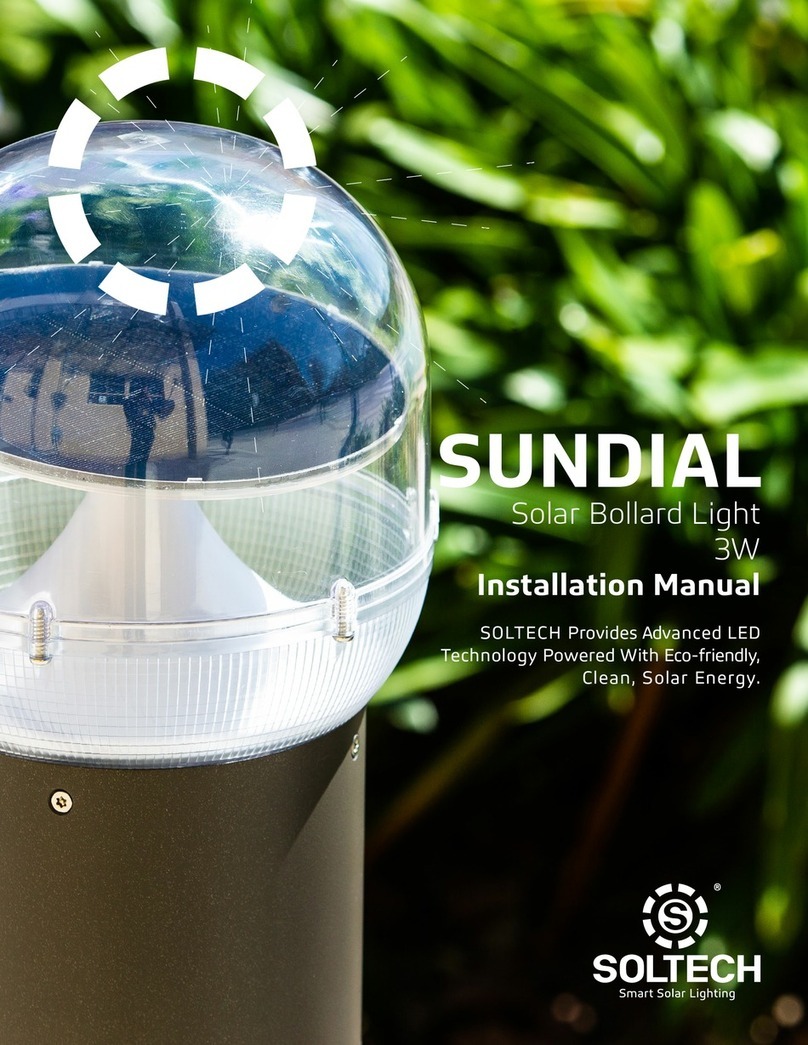
Soltech
Soltech SUNDIAL 3W 13" installation manual

YORKVILLE
YORKVILLE LP-LED2M owner's manual
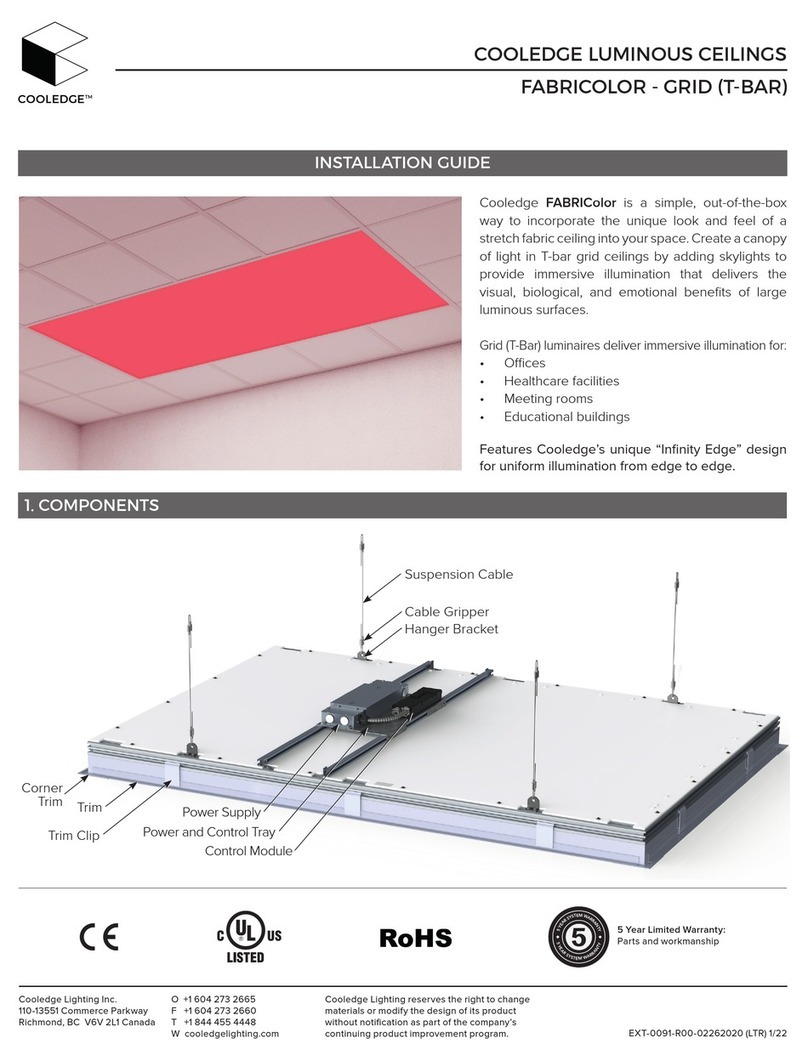
Cooledge
Cooledge FABRICOLOR installation guide
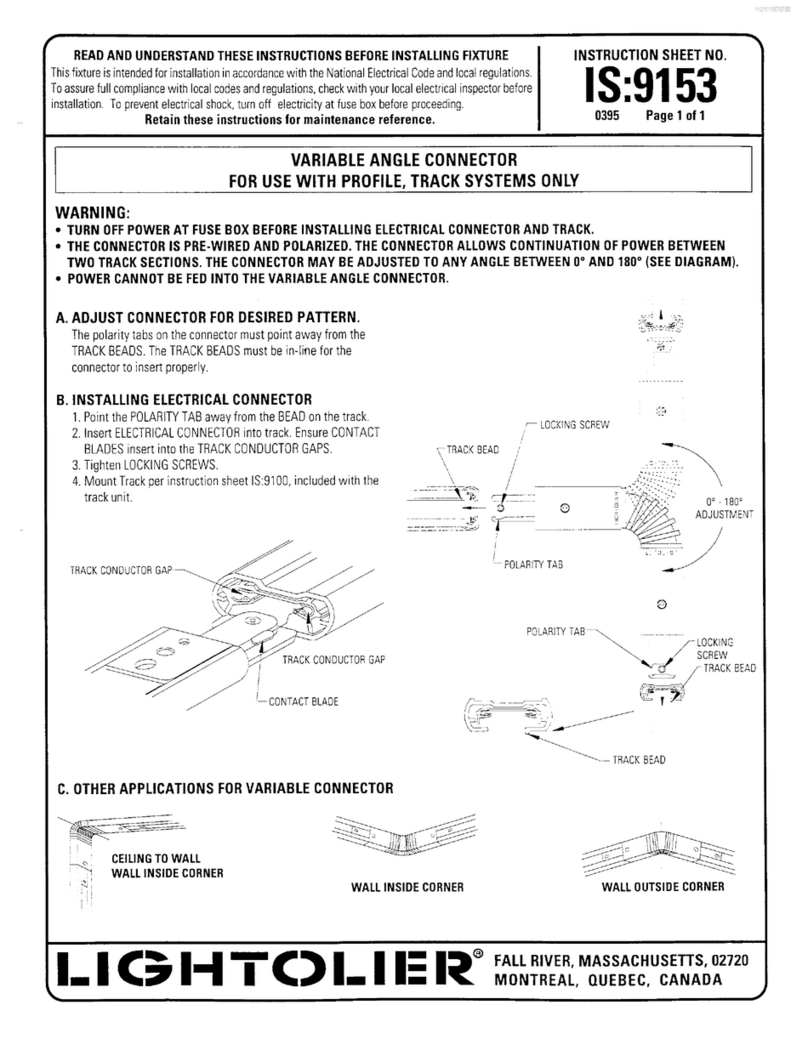
Lightolier
Lightolier VARIABLEANGLECONNECTOR Instructions for maintenance reference
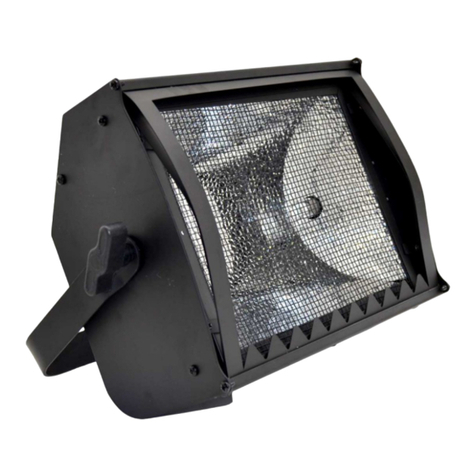
Triton Blue
Triton Blue TR-PA1000 user manual

Diamante
Diamante IN-LYNEA 300 user manual

Leviton
Leviton JCC Emergency Series installation instructions
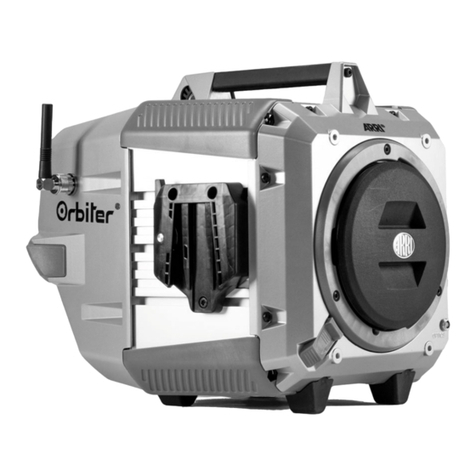
ARRI
ARRI Orbiter Short Instruction
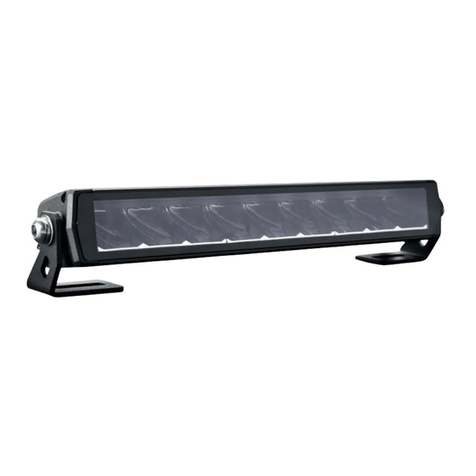
Hamron
Hamron 016048 Operating instruction

LED2WORK
LED2WORK TUBELED 25 RGB-W operating instructions
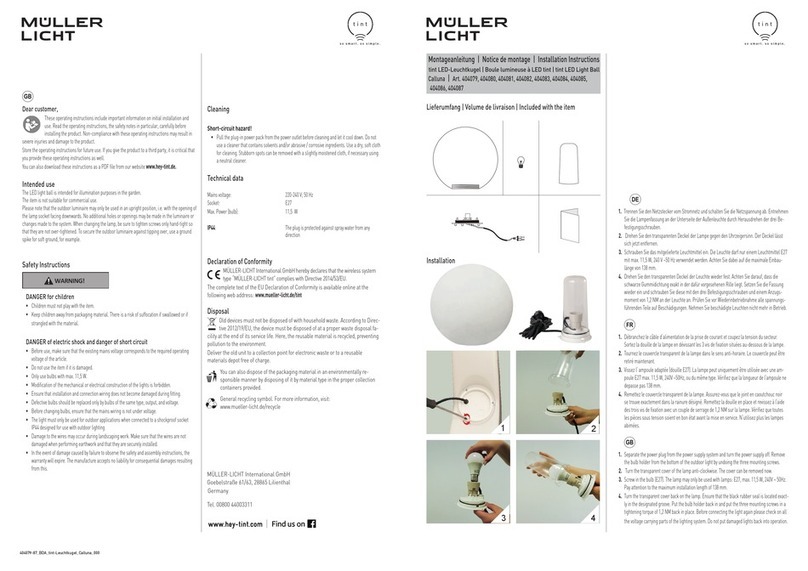
Muller licht
Muller licht Calluna installation instructions
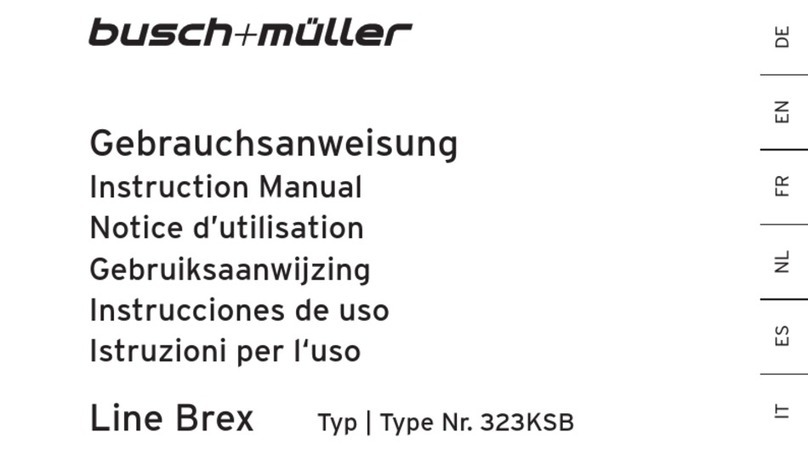
Busch+Müller
Busch+Müller Line Brex 323KSB instruction manual

